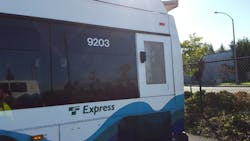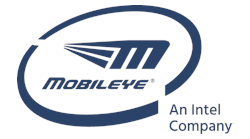A microwave oven-type alarm bleeps and a bus, in turn, swerves to spare an expressionless dummy on wheels and dressed in cuffed jeans and a ballcap. Later, a parked, silver SUV, complete with a school decal in the window, avoids an 8 mph rear-end ramming by another bus from a succinct — and automated — emergency stop.
With the nationwide potential to save lives, reduce damage and cut costs, it’s easy to forgive some drama felt by Pierce Transit risk manager Rob Huyck when he recalls the early safety technology demos by their fleet.
“My heart rate was around 120. It was cool. Terrifying, but cool,” Huyck said.
Pierce Transit was recently awarded $1.66 million from the Federal Transportation Administration for collision warning and autonomous braking technology implementation and research. The total project, with a $2.9 million price tag, will supply all of Pierce’s 176 buses with visual senor and alarm systems, and 30 with an additional emergency braking system. Outside of the grant, Pierce pitched in $500,000, a reinsurer and state insurance pool each supplied $100,000, and in-kind contributions covered the difference.
Pierce is based in Lakewood, Washington, between Seattle and Olympia, and transported 8.6 million riders on its bus fleet in 2016. Huyck detailed approximately 109 pedestrian injuries over the past decade from bus collisions, totaling around $11 million in claims. Huyck estimated 94 percent of the 109 pedestrian collisions could have had a warning if not outright emergency prevention method in place from the incoming technology.
“It might pay for itself within two years as well as reduce suffering,” he said.
The National Transportation Safety Board stated that trucks with collision avoidance systems, autonomous braking and a third feature outside of the Pierce project, electronic stability control, cut collisions by 71 percent.
A yearlong test phase of the technologies had a few kinks. There was what Huyck called a “mixed bag” of initial alarms, some too sensitive to how much space buses took up in driving lanes and another that drivers said sounded too similar to the “stop requested” ping from riders.
Uri Tamir, director of strategic initiatives at Mobileye, the provider of the alert technology, said the bus system visual sensors cover more angles and a larger area of space than those on passenger cars. Amid hundreds of operating miles and 90 terabytes of digital storage from three months of alert data collection, Tamir said the communication by Pierce bus operators was most helpful in modifications.
“It’s very important and helps moving forward because they’ll be the ones working with these types of systems,” Tamir said.
Only when another malfunction had caused the alarm system to be turned off was there a collision involving a bus that carried the system. At the same time, Huyck tallied a 38 percent improvement in operator behavior while the alarm system was on, as drivers left more space between buses and everyone else on the road while in transit.
The braking system, provided by DSC Technologies, will get it’s first, substantial road tests this year. The bus system and the alarm system are separate, and Tamir said he did not expect any compatibility issues. (In one YouTube clip, a Pierce bus slowly approaches an SUV as the alarm sounds increasingly dire. After it stops safely, a Pierce Transit driver brags surprisingly about hovering his foot over the brake but the technology beating him to it.)
The alarm sensors will include changes from the pilot phase, as well as other new features like a warning to pedestrians outside the bus “within a zone of danger” from a digital voice.
Meanwhile, the University of Washington will sift data from the safety instrumentation and Virginia Tech will research the human factors connected with these new technologies.
Mobileye presently has a handful of U.S. transit clients and Tamir said they have pegged a “double-digit number” of bus systems to begin some phase of testing this year.
After rollout in 2017 and research through 2018, Pierce plans to share results at transit conferences and work with the universities on a research paper. Beyond transit agencies, Huyck sees a potential fit for the warning technology on school buses.
There may also be broader financial benefits to a successful safety tech rollout. As collisions represent the primary loss source for Pierce, a drastic reduction could open discussions around lowering insurance costs, according to Huyck, who sits on Washington state’s transit insurance pool board, a project funder.

Justin Kern
Justin Kern is a writer and nonprofit marketing manager who lives in Milwaukee with his wife and cats.



